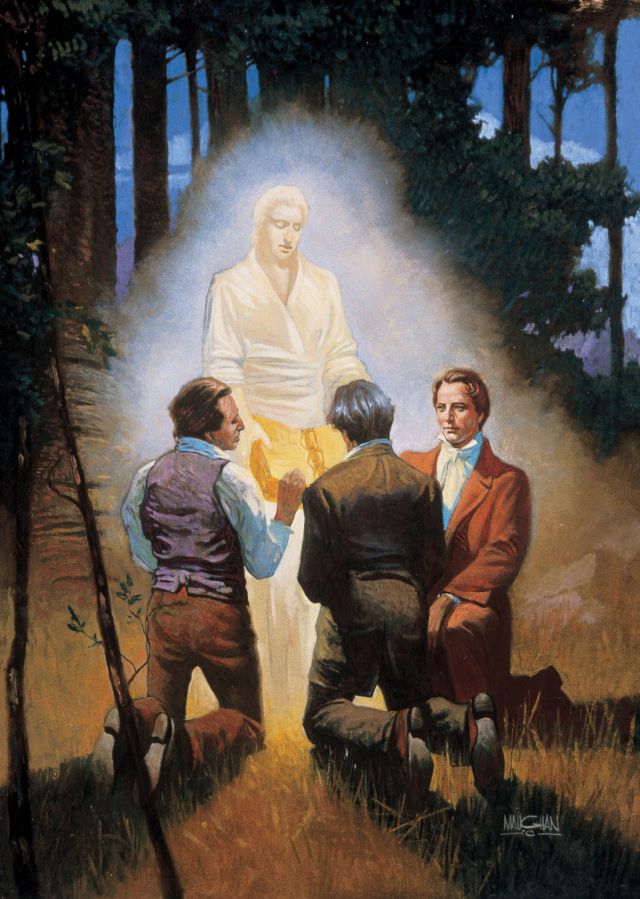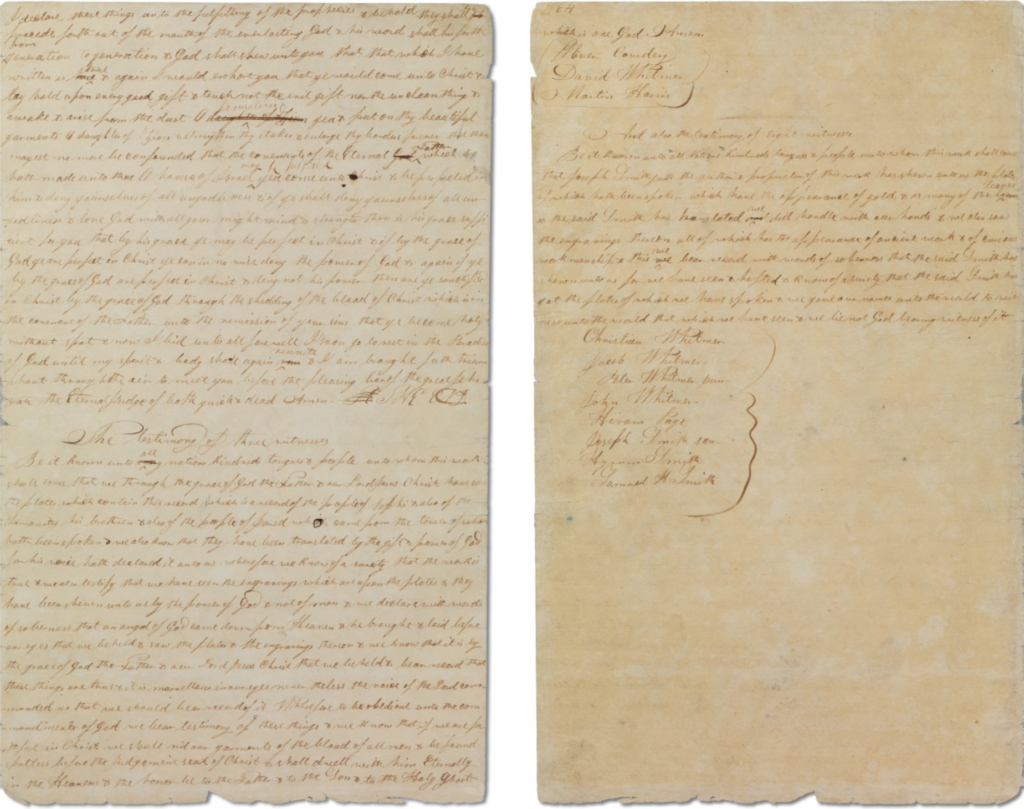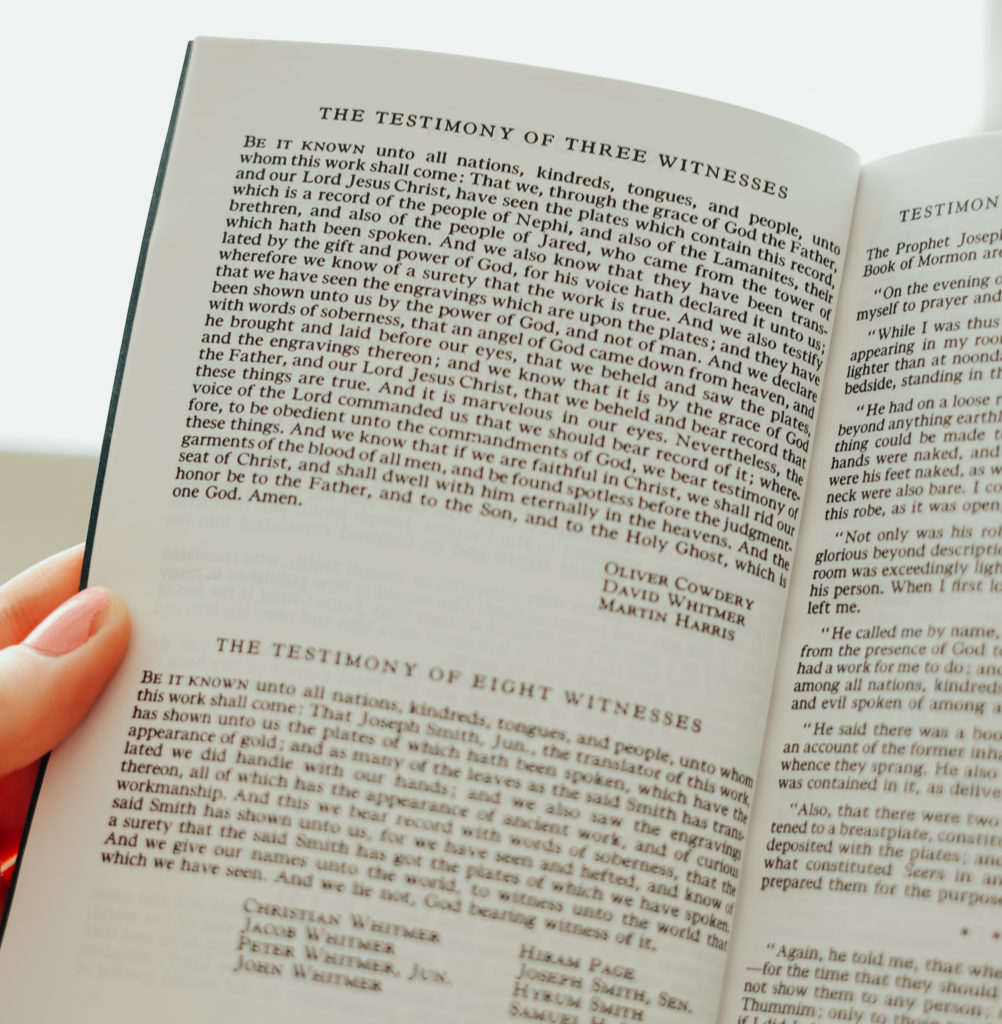Sections 14, 15, 16
Oliver Cowdery kept his acquaintance, David Whitmer, informed about the translation of the Book of Mormon. When antagonism against Joseph grew in Harmony, Pennsylvania, Oliver wrote to David to ask if he and Joseph could finish translating at the Whitmer’s home in Fayette, New York. David himself came with a wagon to transport them, told them his parents would house and feed them for free while they were translating, and promised them all the help they might need.
By early June 1829, they commenced translating in Fayette. The Whitmers and their neighbors were friendly and supportive. Whitmer sons David, Peter, and John were about the same age as Joseph and Oliver, all in their twenties, and especially “zealous,” Joseph’s history says, “and being desirous to know their respective duties, and having desired with much earnestness that I should enquire of the Lord concerning then, I did so, through the means of the Urim and Thummim and obtained for them in succession the following Revelations.”[1]
Section 14 was for David.

It repeats phrases and themes of the marvelous work about to be made known to mankind and the figurative field that is ready for harvest. It also repeats the emphasis on working for Zion, and promises David that if he works to build Zion and endures to the end, God will give him the greatest possible gift: eternal life.
The revelation foreshadows David’s role as one of the three witnesses of the Book of Mormon. David kept many of the revelation’s commands. His testimony of the Book of Mormon, to which he remained faithful, is recorded in every copy. He assisted in the marvelous work. But in David’s case the condition that he “endure to the end” (D&C 14:7) is especially notable. He may not have endured as the Lord intended. Having served for almost four years as president of the Church in Missouri, he was cut off from the church in 1838. He lived for another five decades as a respected citizen of Richmond, Missouri and make a conscious effort to affirm the Book of Mormon while finding fault with Joseph Smith and the Church of Jesus Christ of Latter-day Saints.[2]
The Lord gave essentially the same revelation to both John and Peter, sections 15 and 16, commanding both to hearken to his words as their Redeemer.
They desired to know what would be of most worth to them. The Lord blesses them for this desire and he tells them the most valuable thing they can do is to “declare repentance unto this people, that you may bring souls unto me, that you may rest with them in the kingdom of my father” (D&C 15:6, 16:6).
Like most of the revelations in the Doctrine & Covenants, these ones have an internal rationale. Declaring repentance is the most valuable thing for John and Peter to do, the Lord explains, because it will enable them to rest with the repentant in God’s kingdom. Sections 18, 84, and 93 explain this line of reasoning further, but in these sections we are introduced to the truth that working for the salvation of others is eternally satisfying for ourselves.
Section 17
Two Book of Mormon passages prophesy that “three witnesses” (2 Nephi 27:12) “shall assist to bring forth this work.” They would be shown the Book of Mormon plates so they could know and bear witness of the truth (Ether 5:2-3). Joseph translated the passage in Ether first. By the time he translated the 2 Nephi prophesy he was nearly finished with the Book of Mormon, and there had been plenty of foreshadowing about who the three “who shall assist” could be.
In section 5 the Lord had told Martin Harris that he could qualify if he chose to be humble and faithful. In section 6 the Lord mentioned witnesses and testimony and told Oliver Cowdery that he should “assist to bring forth my work” (D&C 6:9, 28, 31). In section 14 the Lord called David Whitmer “to assist” and prophesied that if he asked of God in faith he would “stand as a witness of the things which you shall both hear and see” (D&C 14:8, 11).
In June 1829 as the translation neared completion at the Whitmers’ home in Fayette, New York, Martin, David, and Oliver pled with Joseph to ask God if they could be the prophesied witnesses. Joseph asked, and the Lord answered with section 17. Joseph rose from his knees and said to Martin, “you have got to humble yourself before God this day and obtain, if possible, a forgiveness of your sins. If you will do this, it is God’s will that you and Oliver Cowdery and David Whitmer should look upon the plates.”[1]
The revelation can be read as a covenant in which the Lord promises Oliver, David, and Martin that if they will rely on his word wholeheartedly, he will show them the Book of Mormon plates.
He also promises to show them the breastplate, Laban’s sword, the seer stones the Lord made for the brother of Jared, and the Liahona that directed Lehi and his family miraculously through the wilderness near the Red Sea. The witnesses will view these artifacts by faith akin to the brother of Jared’s or Lehi’s.
That experience would prove to these men much more than the fact that Joseph had plates. Lehi’s miraculous compass, Laban’s sword, and the brother of Jared’s seer stones testify that the plates are inscribed with ancient writing about actual people who received revelations, knew the Lord, were directed to a promised land, and committed their testimonies of Christ to writing that had been translated by Joseph Smith.
In exchange for such an experience, the Lord obligates the would be witnesses to testify of the Book of Mormon to fulfill his purposes. Their witness will verify Joseph’s, keep him from being overwhelmed, and accomplish the Lord’s righteous purposes. On these conditions, the Lord covenants to resurrect the witnesses at the time of his second coming.
About noon on a late spring day in 1829, Joseph, David, Oliver, and Martin slipped into the woods near the Whitmer home.

“Having knelt down,” Joseph said, “we began to pray in much faith, to Almighty God, to bestow upon us a realization of those promises. According to previous arrangement, I commenced by vocal prayer to our Heavenly Father and was followed by each of the other three.” Nothing happened.
“We again observed the same order of prayer, each calling on and praying fervently to God in regular rotation, but with the same result as before.” Finally Martin Harris confessed that he was responsible for the Lord’s silence. He left the others humbly, disappearing deeper into the woods. “We knelt down again,” Joseph stated, “and had not been many minutes engaged in prayer when presently we beheld a light above us in the air of exceeding brightness and behold an angel stood before us.” He held out the plates for them to see, turning them over one by one. “We could see them,” Joseph testified, “and discern the engravings thereon very distinctly.” A heavenly voice declared, “These plates have been revealed by the power of God, the translation of them which you have seen is correct, and I command you to bear record of what you now see and hear.”
“I left David and Oliver,” Joseph reported, “and went in pursuit of Martin Harris, whom I found at a considerable distance fervently engaged in prayer.” Joseph knelt beside him and their joined faith opened heaven. Joseph saw and heard the vision again while Martin cried out, “mine eyes have beheld, mine eyes have beheld,” and was overcome with joy. Joseph helped him up and they returned to the Whitmer home, rejoicing.[2]
Joseph entered the room where his parents and Mrs. Whitmer were visiting.
“Father! Mother! You do not know how happy I am. The Lord has caused the plates to be shown to three more besides me. They have also seen an angel and will have to testify to the truth of what I have said, for they know for themselves that I do not go about to deceive the people.” The pressure of being the sole eyewitness had, Joseph said, become “almost too much for me to endure. But they will now have to bear a part, and it does rejoice my soul that I am not any longer to be entirely alone in the world.”[3]
Martin, Oliver, and David eagerly told what they had seen and heard.

They wrote a statement of testimony to the whole world that they had seen the engraved plates and heard the voice of God state that they were translated correctly. “We declare with words of soberness,” they affirmed, “that an angel of God came down from heaven, and he brought and laid before our eyes, that we beheld and saw the plates, and the engravings thereon.” It happened just as all the witnesses said. “It is marvelous in our eyes,” they declared together. “Nevertheless, the voice of the Lord commanded us that we should bear record of it; wherefore, to be obedient unto the commandments of God, we bear testimony of these things.”[4]

As Section 17 emphasizes, the witnesses fulfill the Lord’s righteous purposes. They do not compel people to believe. They make everyone able to accept or reject the testimony and accountable for their choice. Witnesses sift people into self-selected categories of believers or unbelievers. “Their testimony shall . . . go forth unto the condemnation of this generation if they harden their hearts,” while those who believe will receive the testimony of the Spirit (D&C 5:5-6).
Sections 14, 15, 16 notes
[1] Dean C. Jessee, editor, The Papers of Joseph Smith: Autobiographical and Historical Writings (Salt Lake City: Deseret, 1989), 1: 294.
[2] Lyndon W. Cook, editor, David Whitmer Interviews: A Restoration Witness (Orem: Grandin, 1991).
Section 17 notes
[1] “History, 1838–1856, volume A-1 [23 December 1805–30 August 1834],” p. 23, The Joseph Smith Papers, accessed July 23, 2020, https://www.josephsmithpapers.org/paper-summary/history-1838-1856-volume-a-1-23-december-1805-30-august-1834/29.
[2] “History, 1838–1856, volume A-1 [23 December 1805–30 August 1834],” p. 25, The Joseph Smith Papers, accessed July 23, 2020, https://www.josephsmithpapers.org/paper-summary/history-1838-1856-volume-a-1-23-december-1805-30-august-1834/31.
[3] “Lucy Mack Smith, History, 1844–1845, Page [11], bk. 8,” p. [11], bk. 8, The Joseph Smith Papers, accessed July 23, 2020, https://www.josephsmithpapers.org/paper-summary/lucy-mack-smith-history-1844-1845/103.
[4] “Printer’s Manuscript of the Book of Mormon, circa August 1829–circa January 1830,” p. 463, The Joseph Smith Papers, accessed July 23, 2020, https://www.josephsmithpapers.org/paper-summary/printers-manuscript-of-the-book-of-mormon-circa-august-1829-circa-january-1830/467.
